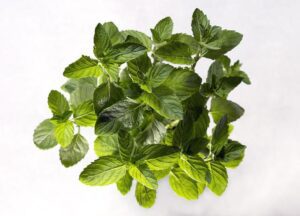Spearmint: (Mentha spicata) aka: Curled Mint, Fish Mint, Garden Mint, Green Mint, Lamb Mint, Mackerel Mint, Our Lady’s Mint, Sage of Bethlehem, Spire Mint.
Spearmint is considered a remedy for indigestion and gas, although its effectiveness has not been officially recognized.
 It is also used to relieve hiccough, flatulence, nausea, vomiting and colic pain, and to treat painful hemorrhoids and for rheumatism.
It is also used to relieve hiccough, flatulence, nausea, vomiting and colic pain, and to treat painful hemorrhoids and for rheumatism.
Spearmint also has antifungal, antiviral, antimicrobial, insecticide, antioxidant, antiamebic, antihemolytic, allergenic, CNS depressant, antihelmintic and antiancylostomiasis activities.
History & Folklore:
This member of the mint family has been held in high regard since Roman times. The ancients believed that it kept milk from souring, and used it as a bath additive, gargle, washing agent, and remedy for bee and wasp stings.
The herb is named for Menthe, a nymph who, according to legend, was turned into a plant by the goddess Persephone when she learned of Pluto’s love for the girl.
The Plant:
It is a perennial herbaceous plant. It is 30–100 cm (12–39 in) tall, with variably hairless to hairy stems and foliage, and a wide-spreading fleshy underground rhizome from which it grows. The leaves are 5–9 cm (2–3+1⁄2 in) long and 1.5–3 cm (1⁄2–1+1⁄4 in) broad, with a serrated margin. The stem is square-shaped, a defining characteristic of the mint family of herbs. Spearmint produces flowers in slender spikes, each flower pink or white in colour, 2.5–3 mm (0.098–0.118 in) long, and broad. Spearmint flowers in the summer (from July to September in the northern hemisphere), and has relatively large seeds, which measure 0.62–0.90 mm (0.024–0.035 in). The name ‘spear’ mint derives from the pointed leaf tips.
Constituents of Spearmint:
It contains an essential oil called Spearmint oil. The chief constituent is carvone, which sometimes causes allergy in users of its preparations. Also present are Phellandrine, Limonene, and Dihydrocarveol acetate, esters of acetic, butyric and caproic or caprylic acids.
Usage:
It is chiefly used for culinary purposes, but it is also used in the aroma and flavor industry.
The medicinal oil is extracted from the above-ground parts of the plant by steam distillation. Today, it is used primarily as a flavoring agent in toothpaste, chewing gum, and certain food preparations. Unprocessed leaves are used as a remedy for gas.
Precautions:
There are no known medical conditions preclude its use. There is a slight possibility of developing an allergy to the oil. Aside from that, the herb appears to be safe.
